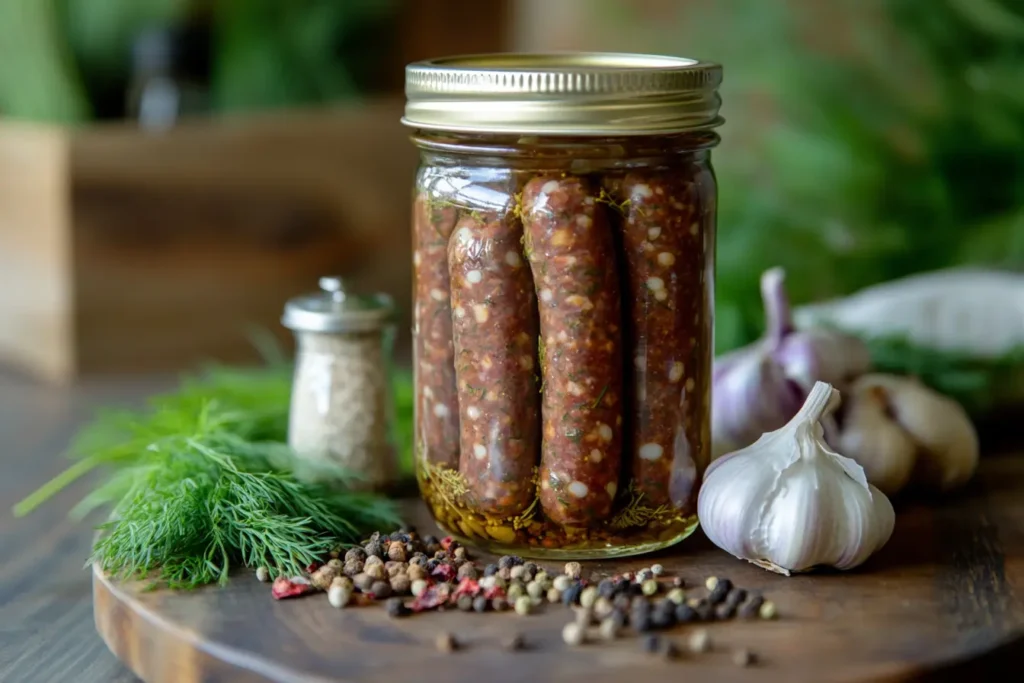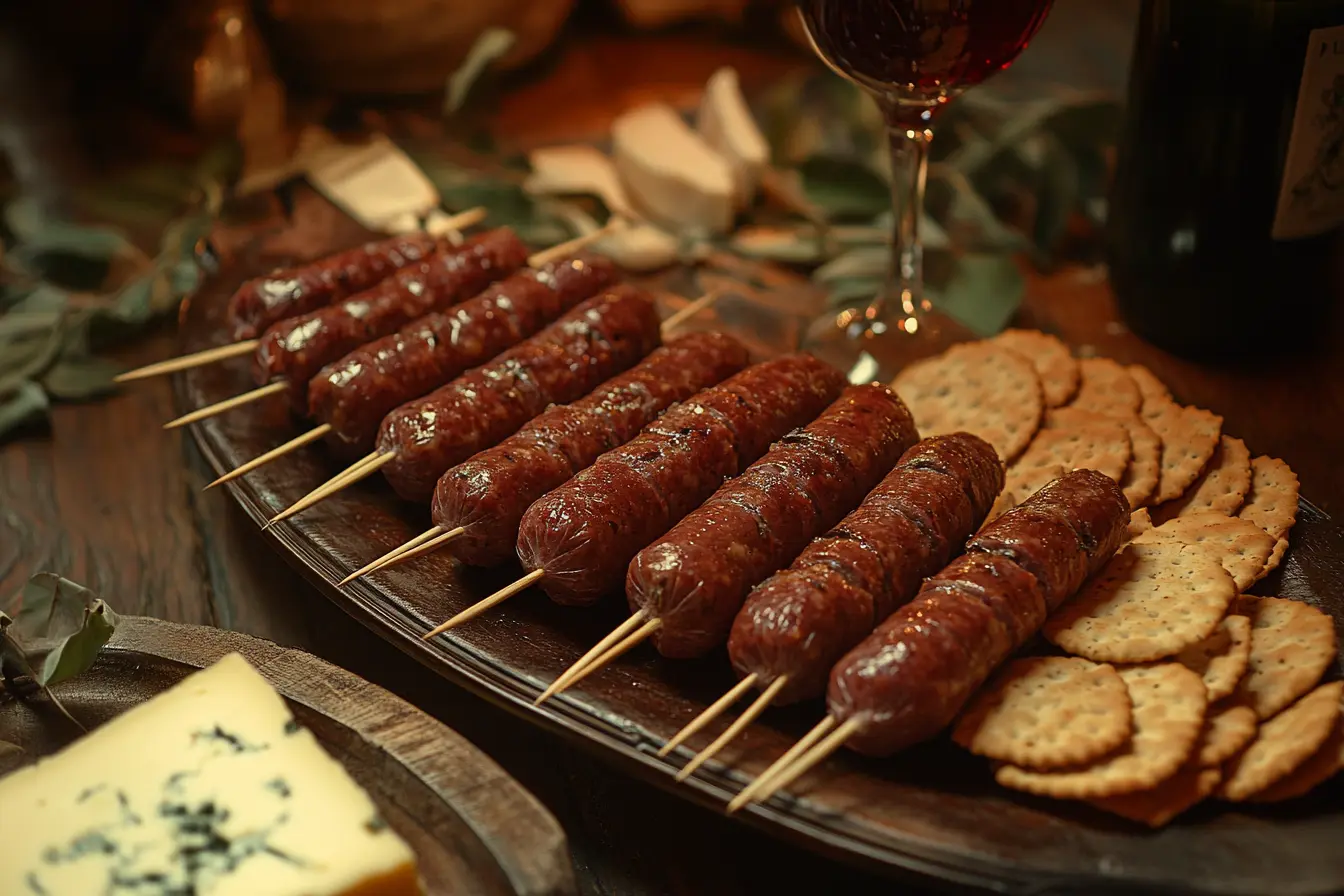Pickled sausage has become a favorite snack in American cuisine, offering a delightful mix of savory meat and tangy, vinegary flavors. As a result, this preparation transforms regular sausages into a tasty treat that works perfectly as a quick snack or as part of a meal. Moreover, people enjoy its versatility, often pairing it with other dishes to enhance the overall dining experience. Therefore, this simple yet flavorful snack continues to grow in popularity across households and restaurants alike.
The sausage serves as the main ingredient, crafted from ground meats such as pork, beef, or turkey. To enhance its flavor, producers season the sausage with a blend of spices and herbs, creating a rich and savory taste. Afterward, they cure and smoke the sausage, which deepens its flavor profile and adds a distinct, satisfying aroma. Furthermore, this preparation ensures the sausage is flavorful, versatile, and ready for the pickling process.
The pickling process soaks sausages in a flavorful brine, which consists of vinegar, water, salt, and pickling spices. Consequently, this method not only preserves the sausages but also infuses them with a tangy, slightly sweet taste that many find irresistible. Additionally, the brine enhances the sausage’s texture and ensures a longer shelf life, making it both practical and delicious.
Key Takeaways
- Pickled sausage is a traditional American snack made from a blend of cured and seasoned meats.
- The key ingredients in pickled sausage include the sausage itself, a brine solution, and various pickling spices.
- The pickling process helps to preserve the sausage and imparts a distinctive tangy and slightly sweet flavor.
- Pickled sausage is a versatile snack that can be enjoyed on its own or incorporated into a variety of dishes.
- The pickling method has been used for centuries as a way to extend the shelf life of sausages and other meats.
Understanding Pickled Sausage: A Traditional Preservation Method
Sausage preservation has been around for centuries. Pickling is a key method to keep sausages fresh longer. It shows how our ancestors preserved food and shaped local cuisines.
Historical Background of Sausage Preservation
The art of making and preserving sausages dates back to ancient times when people relied on methods like salting, smoking, and fermentation to keep meat fresh. Over time, they introduced pickling, which not only preserved the sausages but also enhanced their flavors and textures, creating a tangy and savory delight. Additionally, these techniques played a crucial role in shaping traditional culinary practices and extending the shelf life of meat.
Cultural Significance in American Cuisine
Pickled sausages are a big part of American food traditions. They are found in many regional dishes. For example, kielbasa in the Midwest and chorizo in the Southwest are beloved.
Modern Adaptations of Pickling Methods
- Today, pickling sausages has evolved. Chefs and home cooks try new flavors and methods.
- New pickling techniques, like using different vinegars, have created many sausage varieties. These meet changing tastes and diets.
- The industry keeps updating traditional pickling methods. This meets the needs of today’s consumers.
Pickled sausages are a lasting part of American food culture. They show the versatility and enduring appeal of this preservation method.
What is Pickled Sausage Made Of?
Pickled sausage combines flavorful sausage and tangy pickling brine to create a savory treat. Let’s dive into the key ingredients that make this snack so irresistible.
At its core, pickled sausage starts with high-quality sausage, typically made from pork, beef, or a mix of both. These meats contribute to the sausage’s distinct texture and robust flavor. Options vary, ranging from smoked sausages to fresh ones, each bringing a unique taste to the pickling process.
The addition of spices and seasonings elevates the sausage’s flavor. Popular choices include salt, garlic, black pepper, and paprika, alongside classic pickling spices such as coriander, mustard seed, and bay leaves. These ingredients harmonize with the brine to create a complex and satisfying flavor profile.
The brine is the defining component of pickled sausage. Crafted from a mixture of vinegar, water, and seasonings like sugar, chili peppers, or herbs, the brine not only preserves the sausage but also infuses it with a tangy, slightly sweet taste that complements the savory meat. Together, these ingredients make pickled sausage a timeless and flavorful snack.

“Pickling sausage is a time-honored way to extend the shelf life of this protein-rich ingredient while also creating a unique and flavorful addition to your culinary repertoire.”
Knowing what goes into pickled sausage shows the effort put into making it. Whether you love the classic taste or want to try new ones, pickled sausage is a must-try for food lovers.
Essential Ingredients for Making Pickled Sausages
To make delicious pickled sausages, start by selecting the right ingredients. The key components include high-quality meat, flavorful pickling spices, and a well-balanced brine solution. Each ingredient plays a crucial role in achieving the perfect flavor while ensuring the sausage stays fresh and preserved. By carefully combining these elements, you can create a tangy and savory treat that stands out in both taste and texture.
Primary Meat Components
The meat is the base of pickled sausages. Pork and beef are common choices, giving a rich taste. The meat should be fresh, of high quality, and without gristle or too much fat.
Choosing the right cuts is key for a tender, juicy sausage.
Pickling Spices and Seasonings
- Whole peppercorns
- Garlic cloves
- Bay leaves
- Coriander seeds
- Mustard seeds
- Dill sprigs
These spices and herbs give pickled sausages their unique taste. Salt, sugar, and vinegar mix with them to add a spicy, tangy, and herbal flavor.
Brine Solution Components
- Water
- Salt
- Distilled white vinegar
- Brown sugar
The brine solution is crucial for pickling. It preserves the sausage and adds flavor. The right mix of water, salt, vinegar, and sugar creates the perfect taste and texture.
The Science Behind Sausage Pickling Process
Pickling sausages is a traditional method that boosts their taste and keeps the meat fresh. It uses a mix of salt, acidity, and other ingredients. This mix stops harmful bacteria from growing.
The sausage preservation method works because of salt’s and acidity’s powers. Salt pulls moisture out of the sausage, making it hard for bacteria to grow. The acidity from vinegar or lactic acid lowers the sausage’s pH, making it bad for harmful microbes.
The pickling process also changes the sausage’s taste and texture. The acidic brine tenderizes the meat. The spices and seasonings add unique flavors. Over time, the sausage absorbs these flavors, creating a delicious mix of savory and tangy.
- Getting the right balance of salt, acidity, and other factors is key for perfect pickled sausage.
- Controlling the meat curing process and sausage preservation techniques is important. It makes the sausage tasty and safe to eat.
“The science behind sausage pickling is a delicate dance between preserving the meat and developing its unique flavor profile.”
By understanding the pickling process, both home cooks and chefs can improve their sausage-making. They can make tasty and long-lasting sausages that honor old traditions.
Different Types of Sausages Suitable for Pickling
Not all sausages are good for pickling. Some types work better, bringing out their unique tastes and textures. Let’s look at the best sausage options for pickling.
Smoked Sausages
Smoked sausages are a top pick for pickling. Their smoky flavor and firm texture go well with the tangy brine. Smoking also keeps the sausages from getting too soft.
Fresh Sausage Options
Fresh, uncooked sausages like fermented sausages can also be pickled well. The brine preserves their natural flavors and keeps them from spoiling. This makes for a tasty and unique dish.
Pre-Cooked Selections
Pre-cooked sausages are great for those who want it easy. Cooking them first makes them tender and ready for the brine. This results in a tasty, ready-to-eat pickled sausage.
Choosing high-quality ingredients and following food safety rules is key. With the right steps, you can make a delicious pickled sausage. It will highlight the best of each sausage type.
Step-by-Step Pickling Process
Pickling sausages is a tradition that preserves meat and adds a tangy flavor. If you want to try curing sausage at home, follow this guide for great results.
Start by picking the sausages you want to pickle. Smoked or pre-cooked sausages work best. Clean the sausages well and cut them into sizes you like.
- In a saucepan, mix the pickling brine ingredients. These include vinegar, water, salt, and spices like garlic, dill, and peppercorns. Heat it until boiling, then let it cool down completely.
- When the brine cools, put the sausages in a clean, sterilized jar. Pour the brine over them, making sure they’re covered.
- Seal the jar and put it in the fridge for 2-3 weeks. This lets the sausages pickle and get their flavor. Check the jar and add more brine if needed.
- After 2-3 weeks, the sausages are ready to eat! They can stay in the fridge for months, adding flavor to your dishes.
The secret to great pickled sausages is finding the right mix of acidity, salt, and spices. Try different brine recipes to find your favorite flavor.
Safety Guidelines and Storage Requirements
Keeping pickled sausages safe and tasty is key. It all starts with the right pH levels and following food safety rules.
Proper pH Levels and Food Safety
The pickling process stops harmful bacteria from growing. This is because the brine solution has a pH between 4.6 and 5.2. This acid level stops dangerous bacteria like Clostridium botulinum from causing illness.
It’s important to test the pH levels often and adjust the brine as needed. This step is vital for keeping food safe.
Storage Duration Guidelines
Storing pickled sausages right is crucial for keeping them fresh. They should be kept in the fridge at 35°F to 40°F. Under these conditions, they can last up to 6 months, keeping their taste and texture.
Signs of Spoilage to Watch For
It’s important to watch for signs of spoilage in pickled sausages. Look out for:
- Off-putting odors or discoloration
- Bulging or swollen packaging
- Mold growth on the surface
- Unusual textures or sliminess
If you see any of these signs, it’s best to throw them away. This keeps everyone safe from foodborne illness. Following sausage preservation and food safety rules is crucial for a safe and enjoyable meal.
Health Benefits and Nutritional Information
Pickled sausage is a favorite for many, not just because of its taste. It also has health benefits. Looking into its nutritional profile shows it can be good for a balanced diet.
The health benefits of pickled sausage come from its ingredients. These sausages use quality meats like pork or beef. They also have pickled sausage ingredients that add flavor and help preserve them.
Pickled sausage is high in protein. This is good for muscles, repair, and health. It also has important vitamins and minerals like B vitamins, iron, and zinc.
“Incorporating pickled sausage into a balanced diet can be a delicious way to meet your daily protein and nutrient needs.”
But, it’s key to eat pickled sausage in moderation. It has more sodium and fat than other foods. Eating healthy and watching portion sizes is important.
Knowing the nutritional information and health benefits of pickled sausage helps you make smart choices. With care and moderation, you can enjoy its taste while staying healthy.
Conclusion
Pickled sausage is a special and traditional food loved for generations in America. It started as a way to keep food fresh and has evolved over time. Today, it’s still a favorite snack for many.
Pickled sausage is made with top-quality meats, spices, and a special brine. This process not only makes it taste great but also keeps it fresh longer.
If you love pickled sausages or are new to them, give them a try. Try different sausages, spices, and pickling methods to find your favorite. Enjoy the rich history and culture of this American favorite with every bite.
FAQ
What is pickled sausage made of?
Pickled sausage is made from pork, beef, or other meats. It also includes spices and a pickling solution. The main ingredients are the sausage meat, salt, vinegar, and seasonings like garlic and onions.
How is sausage preserved through pickling?
Pickling preserves sausages by creating an acidic environment. This stops harmful bacteria from growing. The salt and vinegar draw out moisture, making it hard for bacteria to thrive. This also adds a tangy flavor.
What are the essential ingredients for making pickled sausages?
You need meat (pork, beef, or a mix), pickling spices, and a brine solution. The brine is made with vinegar, salt, and water.
What types of sausages are best suited for pickling?
Many sausages work well for pickling, like smoked and fresh sausages. Choose sausages that are firm and can handle the pickling without falling apart.
What is the step-by-step process for pickling sausages at home?
To pickle sausages at home, follow these steps: 1. Cut the sausages into the right sizes. 2. Mix vinegar, salt, water, and spices to make the brine. 3. Put the sausages in a clean, sterilized jar. 4. Pour the brine over the sausages, making sure they’re covered. 5. Seal the jar and refrigerate for 2-4 weeks to let the flavors develop.
What are the food safety considerations for storing pickled sausages?
Keep pickled sausages in a fridge at 40°F or below. Make sure the pH level is below 4.6 to stop bacteria growth. Watch for signs of spoilage like bad smells, sliminess, or mold.
What are the potential health benefits and nutritional information for pickled sausages?
Pickled sausages are a good protein source but can be high in sodium and fat. The pickling process may add probiotics, which are good for health. But, eat them in moderation as part of a balanced diet.

